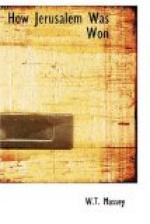but neither anti-aircraft fire nor the presence of
our machines in the air had up to this time deterred
them. However, just at the moment when airwork
was of extreme importance to the Turks, the German
flying men, recognising that our pilots had new battle
planes and were full of resource and daring, showed
an unusual lack of enterprise, and we profited from
their inactivity. The concentration of the force
in the positions from which it was to attack Beersheba
was to have taken seven days, but owing to the difficulties
attending the development of water at Asluj and Khalasa
the time was extended to ten days. During this
period the uppermost thought of commanders was to
conceal their movements. All marching was done
at night and no move of any kind was permitted till
nearly six o’clock in the evening, when enemy
aircraft were usually at rest and the light was sufficiently
dull to prevent the Fritzes seeing much if they had
made an exceptionally late excursion. All the
tents and temporary shelters which had been occupied
for weeks were left standing. Cookhouses, horse
lines, canteens, and so on were untouched, and one
had an eerie feeling in passing at night through these
untenanted camping grounds, deserted and lifeless,
and a prey to the jackal and pariah dog. A vast
area of many square miles which had held tens of thousands
of troops and animals almost became a wilderness again,
and the few natives hereabouts who had made large profits
from the sale of eggs, fruit, and vegetables looked
disconsolate and bewildered at the change, hoping
and believing that the empty tents merely denoted
a temporary absence. But the great majority of
the Army never came that way again.
When the infantry started on the march, divisions
and brigades had allotted to them particular areas
for their march routes, and all over that country,
where scarcely a tree or native hut existed to make
a landmark, there were dotted small arrow-pointed boards
with the direction ‘A road,’ ‘B
road,’ ‘Z road,’ as the case might
be. Marching in the dark hours when a refreshing
air succeeded the heat of the day, the troops halted
as soon as a purple flush threw into high relief the
southern end of the Judean hills, and they hid themselves
in the wadis and broken ground; and on one unit vacating
a bivouac area it was occupied by another, thus making
the areas in which the troops rested as few as possible.
The concentration was worked to a time-table.
Not only were brigades allotted certain marches each
night, but they were given specified times to cover
certain distances, and these were arranged according
to the condition of the ground. In parts it was
very broken and covered with loose stones, and the
pace of infantry by night was very slightly more than
one mile per hour. The routes for guns were not
chosen until the whole country had been reconnoitred,
and it was a highly creditable performance for artillery
to get their field guns and heavy howitzer batteries




